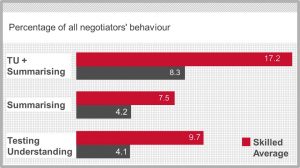The acid test of an effective negotiation is the durability of the deal. In large, complex negotiations deals that can stand the test of time are going to be those that have been well thought through and considered by both sides.
To arrive at a robust and implementable deal a key thing to strive for at the negotiation table is clarity. By this I mean clarity in terms of the proposal on the table and the implications of that proposal for both sides. Unsurprisingly therefore one of the key behavioural differences between skilled and average negotiators that emerged in our early negotiation research was their use of two behaviours we call Testing Understanding and Summarising. As the graph shows, skilled negotiators used twice as much of these behaviours as did average ones, especially in relation to Testing Understanding.
Just to clarify what we mean by these behaviours; in Huthwaite terms a Summary is a behaviour that restates in a compact form the content of a discussion. Testing Understanding is a behaviour that seeks to establish whether or not an earlier contribution has been understood. Examples are: “Are you saying that…” or “Can I take it that we are all now agreed on this?” A Summary can also become a Testing Understanding, simply by adding a question at the end such as: “Have I got that right?”
 Using 'Testing Understanding' to negotiate effectively – research findings
Using 'Testing Understanding' to negotiate effectively – research findings
These behaviours are so important that I recently took the opportunity to interview one of Huthwaite’s original researchers, Linda Marsh about the use of them in both negotiations and meetings. We first uncovered the power of Testing Understanding and Summarising in our earliest research into effective meeting behaviours. Our meeting research discovered that if the level of Testing Understanding/Summarising fell below 10% of the overall behaviours used in the meeting then the number of misconceptions between those present as to what had been discussed and agreed would rise sharply. Interestingly, if the percentage of Testing Understanding and Summarising rose above 10% then this did not reduce the number of misconceptions any further, so 10% appeared to be an optimum level. Indeed, as with anything, you can have too much of a good thing. Too much Testing Understanding and Summarising tends to slow meetings down and they can lose energy.
In negotiation however, the level of combined Testing Understanding and Summarising was even higher, which reflects its particular importance in this particular situation. Not only is it a tool for reducing misunderstanding but it also enables negotiators to kick a proposal around between them, gets people to rethink proposals and really think through the implications of what is on the table.
We also found skilled negotiators using Testing Understanding as an alternative to disagreement to negotiate effectively. So if somebody puts a proposal on the table that they want to challenge they might ask a question like: “Are you saying that….” Or “Does that mean that ….”. However, there is a challenge in using this type of behaviour, and this is related to tone of voice.
Skilled negotiators use this behaviour with a puzzled tone of voice. The message that is then sent to the other side is one of “I’m confused; please help me out.” It then is more likely to have the desired effect of getting the other person to rethink what they have just said, especially the implications of what they have just said that they may not have thought through for themselves.
Dangers of using 'Testing Understanding' ineffectively
Alternatively this behaviour can be delivered in a more incredulous-sounding or aggressive way. “Are you really saying that…?” In this case it may not always have the desired effect; instead it might just aggravate the other side. We have seen this happen many times when this behaviour is used, as people regard it as patronising rather than helpful. Used with real aggression the behaviour becomes a form of Defend/Attack rather than Testing Understanding.
The potentially aggressive nature of Testing Understanding used in this way is probably why in our 2014 global survey people generally avoided using the example we used, which was “Are you seriously saying that you want to treble the payment terms when you will not move on price?” However we did find that Successful people (those where more than 75% of their negotiations were implemented successfully) were more inclined to use it than the Unsuccessful people (who had to renegotiate more than 50% of their negotiations). This reinforces its importance as a behaviour that will help you to negotiate effectively and achieve robust, implementable negotiation deals.
So next time you are in a negotiation, or indeed in any form of conversation with someone, consider how much you are using Testing Understanding or Summarising. A simple way to integrate it more into your conversations is to remember to take a break once in a while and just summarise back to the other person your understanding of the conversation to date. You just might find it has a dramatic effect on your conversation and on the outcome.








